The predictive vs. the simulating brain: A literature review on the mechanisms behind mimicry
Keywords:
social cognition, forward models, mirror neurons, behavioral synchronyAbstract
Is it possible to understand the intentions of other people by observing their actions? And how does unconscious mimicking and synchronizing to behavior from other people relate to that? Behavioral synchrony and mimicry are important elements of social cognition. Their settings and effects have been well studied. However, the neurobiological mechanism behind them remains unclear. This review illuminates two neuroscientific approaches to explain the mechanism behind behavioral synchrony and mimicry. On the one hand, simulation through the mirror neuron system (MNS) describes behavioral synchrony as a by-product of simulation by certain motor-neurons. On the other hand, forward and inverse models, an internal prediction about future events, seem to be an important concept in motor control and have been suggested to be involved in social cognition as well. The author proposes that behavioral synchrony relates to forward and inverse models by acting as a facilitator of social cognition. A better prediction, due to behavioral synchrony, leads to a better understanding of others. Furthermore, limitations of the given approaches are illuminated.
Downloads
Published
Issue
Section
License
Authors can use either their accepted author manuscript for:
- Use at a conference, meeting or for teaching purposes.
- Internal training.
- Sharing individual articles with colleagues for their research use (also known as 'scholarly sharing').
- Use in a subsequent compilation of the author's, or the supervisor's works.
- Inclusion in a thesis or dissertation.
- Reuse of portions or extracts from the article in other works.
- Preparation of derivative works (other than for commercial purposes).

